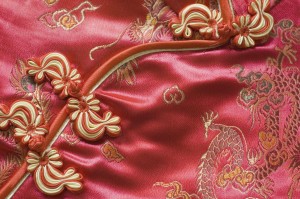CHRIS HOUSTON on 26 September, 2014 at 03:09
Next door to Paul Bishop's biweekly class, which outlined the finer points of corporate finance to an overflow crowd, I gathered with a small group of second year students in my MBA program to learn the more obscure discipline Dick Hodgson called, "Creative Professional Leadership" that he was pioneering. Among an eclectic set of learning exercises, he required us on occasion to sit in the dark and listen to the monotone chants of the mystic Ram Das, while our more practical neighbors in the classroom next door were no doubt riveted by β calculations and risk-adjusted-costs-of-capital in the sterile glow of the fluorescent bulbs overhead. As it turns out, Dick was on to something; but his course would have been even more preparatory for the requirements of business today if he had taught us embroidery, Chinese embroidery.In Eastern China, not far from Shanghai, lies a small city called Suzhou (Su Xiu). There, in Jaingsu province, for well over a thousand years, artisans have practiced one of the four ancient styles of Chinese silk embroidery. Su embroidery is distinct because of its most intricate stitching techniques. The silk thread used by Su embroiderers, already as fine as a human hair, is split again and again to yield finer and finer material for detail. After millennia of practice, more than forty different stitch types can be distinguished.This art form takes decades to master, and each piece requires months of painstaking and highly detailed work. Perhaps the most distinctive style to emerge within this remarkable craft is double-sided embroidery. It is Su embroidery's most exquisite form, where, from the same threads, two distinct images are formed on opposite sides of a single panel. As one image is formed on one side, the artist creates at the same time the second image, whereby the movement and brilliance of one should infuse life into the other, as if the two silk images were dancing as one. These most exquisite works are best displayed vertically, suspended between two glass panes so that both sides might be observed at once.
The identity that a company puts forth to its customers, its partners and its various publics, is, of course, what we encounter as its brand or identity. But there is a companion dimension of company identity called culture to which the same aspects of identity also apply.
It was once quite possible for the external identity to bear little resemblance to the internal identity. In the past, a brand could be sustained that held little in common with the culture of the organization. Over time, such inconsistency has proved untenable. Arthur Anderson could not promise trustworthiness of its independent audits and at the same time act duplicitously at Enron for the sake of making money. Nor could Lehman Bros build a public image of reliable investment returns while it was saddled with the insolvency of toxic assets. Today, the brand must match the culture, or else the bloodhounds on social media will track the real identity with great haste and when they have located it, yelp ferociously until others are aware of their discovery.
As my colleague John Seifert reminds me, "authenticity is the new coin of the realm". Which, of course, is why business leaders need to learn Su embroidery. In too many companies, the functions most responsible for brand (often marketing related) rarely understand, much less collaborate, with those who shape and develop the culture (often HR, finance and corporate communications).
An organization stitches together a group of people and tasks and attitudes and behaviors as people join together to do the work. The multiplicity of choices about messages, investments, pricing, budgets, compensation, governance and the way it acts against those choices will produce a very real identity – the way it thinks, acts, looks and sounds as encountered by its people inside. At the same time those tendencies, choices and actions will be encountered by others external to the company as the brand.
Yet, instead of attending to the more difficult but longer-lasting questions of identity, too many companies occupy themselves with silver-bullet marketing spend, the patterns suggested by analysis of "big data" or the quick-fixism of competitor imitation to suggest how they might profitably transact with customers and employees
Not long ago, leaders and their companies could get away with mixed messages and "say-do" gaps. Not anymore. [TWEET THAT!]
I am reminded of the words of Edna St. Vincent Millay, written in 1939, which speak to us now–in the age of data and facts and yet escalating confusion and uncertainty–
Upon the gifted age, in its dark hour,
Rains from the sky a meteoric shower
Of facts … they lie unquestioned, uncombined.
Wisdom enough to leech us of our ill
Is daily spun; but there exists no loom
To weave it into fabric.
-from "Upon This Age That Never Speaks Its Mind,"
We must become like embroiderers, capable of creating two beautiful, distinct, but deftly interwoven images—one of brand, the other of culture–with the same thread, lest our customers and employees slowly gravitate to those leaders and organizations who have learned this most intricate of art forms.
